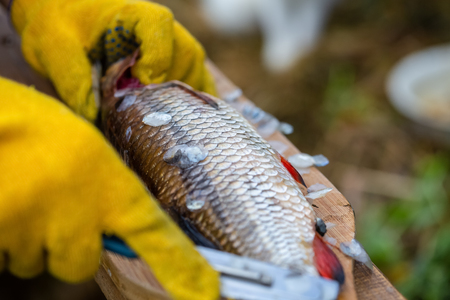1. Understanding Pike Behaviour in Winter
As the British winter sweeps across the countryside, pike behaviour transforms in ways that present both challenges and opportunities for anglers. The drop in water temperature slows their metabolism, making these apex predators less active than during the warmer months. Still, a keen naturalist’s eye reveals subtle shifts: pike seek out deeper, slower-moving stretches of rivers and lakes, often congregating near submerged structures or reed beds that offer shelter and ambush points. Their feeding patterns become more sporadic, with short bursts of activity during the mildest part of the day when light and temperature peak ever so slightly. For the angler attuned to these seasonal cues—watching for frosted banks, reading the movement of over-wintering waterfowl, and noting changes in weed growth—the British winter offers a unique advantage. By understanding how pike respond to cold weather conditions, you can pinpoint likely locations and time your efforts for those fleeting moments when these formidable fish are most likely to strike.
Essential Winter Pike Fishing Kit
When it comes to winter pike fishing in the UK, your choice of kit is more than a matter of comfort—it’s essential for both safety and success. Braving the biting chill by rivers, reservoirs, or fenland drains calls for gear that can withstand frost-laced mornings and unpredictable conditions.
Insulated Clothing: Layering Up for the British Cold
The key to enduring hours by the water is layering. Start with a thermal base layer to wick away moisture, add a fleece mid-layer for insulation, and finish with a waterproof, windproof outer shell. Don’t forget thermal socks, fingerless gloves for dexterity, and a good quality beanie—heat loss from your head can sap your energy fast. Many anglers swear by a neck gaiter or snood for extra protection against biting winds sweeping across the fens or lakes.
Robust Tackle: Built for Winter Conditions
Pike are formidable predators, and winter often brings out their full power. Choose rods with enough backbone to handle hard-fighting fish yet sensitive enough to detect subtle takes. Reliable reels with smooth drag systems are vital—frozen fingers make adjusting fiddly gear a nightmare. Monofilament lines can stiffen in the cold, so many UK anglers opt for braided mainline with a strong fluorocarbon leader.
Recommended Tackle Setup
| Tackle Component | Recommended Specs |
|---|---|
| Rod | 10-12ft, 2.75-3.5lb test curve |
| Reel | 4000-6000 size, smooth drag |
| Mainline | 30-50lb braid |
| Leader | 20-30lb fluorocarbon or wire trace |
| Hooks | Size 6-8 trebles (barbless preferred) |
Must-Have Gear for Frosty Mornings
Beyond rod and reel, some kit is indispensable on wintry banksides. An unhooking mat prevents damage to pike on icy ground; long-nosed pliers make hook removal safer and easier when your hands are numb; and an insulated flask of hot tea or coffee is a British staple—nothing restores feeling like a steaming cuppa at dawn.
Pike Fishing Essentials Checklist
- Thermal layered clothing (base, mid, outer)
- Waterproof boots with grippy soles
- Fingerless gloves & beanie hat
- Braided line & sturdy rod/reel combo
- Unhooking mat & long-nosed pliers
- Flask of hot drink & high-energy snacks
- Headtorch for dark mornings or late finishes
- Landing net suitable for large pike
- Bite alarms and bank sticks (for static deadbaiting)
- Towel or handwarmer for comfort between casts
Kitted out properly, you’ll not only stay warm but also keep your focus sharp—ready to react when that elusive winter pike makes its move.

3. Best Locations for Cold Weather Success
When the mercury drops and frost crisps the banks, the UK’s classic pike waters come into their own, offering both challenge and reward for winter anglers.
Lakes: Stillwater Havens
Among the most celebrated are the great lakes of Cumbria and the Midlands—think Windermere, Chew Valley Lake, and Rutland Water. These vast bodies of water offer deep holes and weedy bays where pike lurk during colder months. Focus on areas near drop-offs or submerged features; these act as winter refuges where prey fish gather, drawing hungry predators in close.
Rivers: Moving Water Magic
The River Thames, Trent, and Norfolk’s Wensum are renowned for their winter pike sport. On rivers, seek out slow-moving backwaters, slack margins, or deeper bends where the current eases—pike often conserve energy here when water temperatures plummet. Pay attention to overhanging trees and reed beds, which provide natural cover.
Broads: East Anglia’s Pike Paradise
The Norfolk Broads truly shine in winter, with legendary venues like Hickling and Barton Broad producing specimen fish year after year. In these labyrinthine waterways, look for clear channels adjacent to reed-fringed margins and boat moorings. Pike often patrol these areas at first light or just before dusk.
Tips for Identifying Productive Swims
Use your eyes and intuition—watch for baitfish activity, bird movement (diving grebes are a giveaway), or subtle surface disturbances. Local knowledge is invaluable; don’t hesitate to chat with regulars at the bank for insights into recent hotspots. Remember that pike may shoal together in cold weather, so once you find one, there’s a good chance more are nearby. Ultimately, blending classic venues with careful swim selection is key to unlocking winter success on Britain’s legendary pike waters.
4. Bait and Lure Choices for Chilly Conditions
When the mercury drops and the UK’s waters turn icy, pike behaviour shifts dramatically. They become noticeably more sluggish and selective, making your bait and lure selection absolutely crucial for winter success. The right choices can mean the difference between a blank session and a personal best.
Best Deadbaits for Winter Pike
Deadbaiting remains a time-honoured British approach when targeting lethargic pike in cold water. Here’s a handy table to guide your selection:
| Deadbait | Why It Works | Top Presentation Tips |
|---|---|---|
| Smelt | Strong scent; soft texture; local favourite on many venues | Fish whole or as half sections; ledger or float rig just off bottom |
| Sardine | Oily flesh releases attractive scent trails in cold water | Lip-hook for natural flutter on retrieve; secure with elastic thread if needed |
| Mackerel | Tough skin stays on hook longer; high oil content appeals to big pike | Use as chunks or tail sections; ideal for static bottom rigs in deeper waters |
| Roach | Natural prey item for wild UK pike; subtle scent but visually appealing | Fish whole on single treble; great for clear venues where pike are wary |
Lure Selection: Downsizing & Subtlety
Pike often ignore aggressive lures in winter, so switch tactics with finesse:
- Soft Plastics: Shads and paddle tails around 10-15cm fished slowly along the bottom mimic injured baitfish.
- Spoons: Use smaller, slower-wobbling models for a gentle flash that tempts pike without spooking them.
- Jerkbaits: Neutral-buoyant, suspending jerkbaits allow you to pause mid-retrieve—an irresistible trigger for torpid fish.
- Spinnerbaits: Go compact with muted colours on cloudy days; retrieve steadily with occasional pauses.
Presentation Techniques: Less is More
The key to winter presentation is subtlety and patience. Whether deadbaiting or lure fishing, slow down your approach. Let deadbaits settle naturally and avoid excessive movement. When working lures, use long pauses and gentle twitches to give pike time to commit. Consider using fluorocarbon leaders for extra stealth in clear water, especially on pressured day-ticket lakes.
5. Safety and Etiquette on the Bank
Winter pike fishing in the UK is a pursuit that demands both caution and consideration, especially as temperatures plummet and banks become slippery underfoot. Cold-weather safety should always be your top priority: dress in thermal, waterproof layers, wear sturdy boots with good grip, and never underestimate the chill of the wind when near water. A flask of hot tea is more than a comfort—it’s a lifeline for keeping your core temperature up between casts. Always let someone know your location before heading out, and keep your mobile fully charged in case of emergency.
Respecting fellow anglers is another hallmark of British bank-side etiquette. Give others plenty of space—not just for safety, but to avoid spooking wary winter pike with too much activity. Greet your neighbours with a friendly nod or quiet word; it’s part of the charm of fishing in Britain’s shared waters. Keep noise to a minimum and tidy up after yourself—no one wants to find discarded hooks or sandwich wrappers when they arrive for a dawn session.
Lastly, in cold conditions, caring for the fish becomes even more important. Pike are especially vulnerable when water temperatures drop. Use unhooking mats to protect them from frozen ground, handle them gently with wet hands or gloves, and ensure you return them swiftly to the water once revived. The health of our fisheries depends on anglers’ stewardship—when we look after both fish and each other, everyone enjoys a better day out.
6. Reading Nature: Seasonal Subtleties
One of the true hallmarks of an accomplished winter pike angler in the UK is a keen ability to read the natural world. Beyond rods, reels, and rigs, it’s your senses that often make the difference on those biting cold days. Observing local wildlife and subtle weather shifts can reveal far more about where pike may be lurking than any digital device.
Take, for instance, the sudden flight of coots or mallards across a misty fen or reservoir. Such commotion frequently points to an unseen predator—perhaps a hungry pike on the move beneath the surface. Similarly, watch for gulls or grebes congregating over shoals of baitfish; predators are rarely far behind in these scenarios.
Weather cues play their part too. A mild spell after a hard frost can bring pike into shallower margins, especially around midday when weak sunlight warms the water just enough to stir prey species. Conversely, during prolonged cold snaps, you might find success by targeting deeper holes or slow-moving stretches where fish seek refuge from icy currents.
Embrace the British habit of taking a thermos and simply watching for a while before casting out. Notice how wind direction affects floating debris or how water clarity changes after overnight rainfall. The subtle rise of a silver-sided roach or the ripple of a disturbed weed bed can all provide vital clues if you’re patient enough to observe.
In short, becoming an intuitive winter pike angler is as much about immersing yourself in the landscape as it is about tackle and tactics. Let nature be your guide—read its seasonal subtleties with care, and you’ll find your cold-weather fishing both richer and more rewarding.

